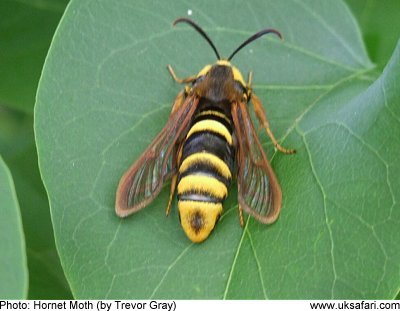 Hornet Moths
Hornet Moths
Identify It > Moth Section > Hornet Moths >

Scientific name: Sesia apiformis
Size: Wingspan up to 44mm
Distribution: Rare. Found in parts of England (mainly midlands southwards) and Wales
Months seen: June to August
Habitat: Woodland edges, hedgerows, commons, parks and poplar trees in open spaces
Food: Larvae feed on the wood of poplars and aspen
Special features: Hornet Moths are so called because of their similar appearance to hornets. To add to the effect they even have clear wings. After emerging from their cocoons, the young moths lose most of their wing scales leaving a transparent window on each wing.
They are similar in appearance to Lunar Hornet Moths, but that species has a black head while Hornet moths have a yellow head.
The disguise is very convincing but you'll notice they don't have the usual narrow waist between the abdomen (back end) and the thorax (middle bit).
The caterpillars are cream coloured with black heads. They overwinter at least twice and then pupate for a further winter. They feed on the wood just under the bark of poplar trees, usually at ground level. The eggs are laid on the bark, and the larvae burrow into the wood.
Hornet Moths are scarce in the UK. As you'd imagine, with just a casual glance they can be easily mistaken for a hornet or wasp.
Sightings
2013 - Thurrock, Essex - Trevor Gray

